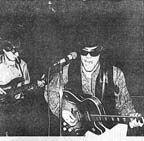 Another pillar of SD punk's plastic arts (along with music, tattoos and flyers) were 'zines, the samizdat publications created by luminaries such as Marc Rude, Harold Gee, Terry Marine and Clayton Colgin.
Another pillar of SD punk's plastic arts (along with music, tattoos and flyers) were 'zines, the samizdat publications created by luminaries such as Marc Rude, Harold Gee, Terry Marine and Clayton Colgin.
Over in the Che Underground forum (separate registration required), Dean Curtis and Toby Gibson, among others, have been bringing these treasures to light. One of Dean's first contributions was Issue 2 of Quasi-Substitute, dating from 1980 and featuring the Crawdaddys on the cover.
 Its reappearance prompted this wonderful response from David Klowden: "Seeing this issue of Q-Sub triggered an intense emotional stew of white hot longing for that place and time, deep black terror at the passage of the years & a kind of fatherly love for my younger self that is beyond description.
Its reappearance prompted this wonderful response from David Klowden: "Seeing this issue of Q-Sub triggered an intense emotional stew of white hot longing for that place and time, deep black terror at the passage of the years & a kind of fatherly love for my younger self that is beyond description.

 I was searching online for my former mentor, Renee Edgington, the founder of Shark Productions, who was responsible for creating so many cool shows in San Diego, and learned that she & her husband died in a car accident 10 years ago while vacationing in South Africa.
I was searching online for my former mentor, Renee Edgington, the founder of Shark Productions, who was responsible for creating so many cool shows in San Diego, and learned that she & her husband died in a car accident 10 years ago while vacationing in South Africa.













 David Klowden --
David Klowden --